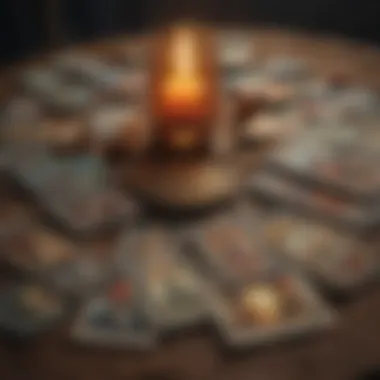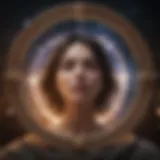Mastering Online Tarot Reading: Your Complete Guide


Intro
Tarot reading has long captivated those seeking insight and self-discovery. In recent years, the rise of digital platforms has made tarot more accessible to a wider audience. Online tarot reading offers a unique blend of tradition and technology. This guide aims to equip you with the knowledge needed to navigate this evolving landscape.
Before delving into the practical aspects of tarot reading online, it is important to understand the context and history of this fascinating practice. Tarot cards originated in the 15th century as a card game in Europe. Over time, they evolved into tools for divination and self-reflection.
In this comprehensive guide, we will cover various aspects of online tarot reading. Topics will include types of readings, tips for beginners, interpretation techniques, and the impact of technology on traditional practices. By the end of this article, you will have a nuanced understanding of how to engage with tarot in an online environment.
Understanding Tarot
Understanding Tarot is crucial for anyone interested in exploring the depth of tarot reading online. This segment serves as the foundation for grasping the intricacies of using tarot as a tool for introspection and guidance. In this article, we will delve into the historical background of tarot, its essential components, and the significance of interpreting the cards accurately. Grasping these elements will enable readers to engage meaningfully with the practice of tarot.
Historical Context
The origins of tarot can be traced back to the 15th century in Europe, where it began as a card game. Over the centuries, its purpose evolved from entertainment to a means of divination. Early decks often featured allegorical imagery, which was slowly further enriched by various cultural influences. By the 18th century, tarot became associated with mystical practices, gaining popularity among esoteric traditions. Understanding this context helps readers appreciate the tarot's journey through time and its eventual transformation into a respected tool for insight and reflection.
Components of Tarot Decks
Tarot decks comprise two main parts: Major Arcana and Minor Arcana. Each has its distinct role.
Major Arcana
The Major Arcana consists of 22 cards that symbolize significant life events and spiritual lessons. Each card within this suit carries deep, often archetypal meanings that resonate with profound aspects of human experience. Major Arcana cards are crucial for interpretation due to their association with transformational phases in life. They tend to be more impactful in readings, as their messages can highlight major themes or issues requiring attention. This makes the Major Arcana particularly popular among both novice and experienced readers.
Minor Arcana
In contrast, the Minor Arcana contains 56 cards divided into four suits. Each suit represents different facets of everyday life. While the Minor Arcana cards do not typically address life-altering events like the Major Arcana, they provide valuable insights into day-to-day concerns and emotional landscapes. Understanding these cards helps readers connect the dots between larger life themes and immediate issues they face.
Suits and Their Meanings
The Minor Arcana is divided into four suits: Cups, Swords, Wands, and Pentacles. Each suit has its specific association and represents various areas of life.
- Cups: Related to emotions, relationships, and connections with others.
- Swords: Symbolizes intellect, conflict, and challenges.
- Wands: Represents creativity, inspiration, and action.
- Pentacles: Relates to material aspects, finances, and stability.
Each suit contributes to a well-rounded understanding of a reading, guiding the interpreter toward nuanced insights about personal situations.
Significance of Card Interpretation
The interpretation of tarot cards is an art that requires not just knowledge of meanings but also intuition and personal connection to the symbols presented. The way cards interact during a reading can reveal layers of meaning. Each card can embody numerous interpretations, thus requiring the reader to analyze them within the unique context of the inquiry. The significance of card interpretation lies in its ability to uncover hidden truths and facilitate self-awareness, affirming tarot's role in personal growth and reflection.
In summary, a solid understanding of tarot is vital for effective online readings. This encompasses the historical context, the structure and components of tarot decks, and the importance of interpreting cards with care and insight.
The Online Tarot Landscape
The expansion of tarot reading into online platforms has transformed not only the accessibility of tarot but also how it is perceived and practiced. This era has brought new opportunities for both readers and seekers, allowing for a diverse range of experiences and interpretations. Understanding the online tarot landscape is vital as it illuminates the modern practices that have evolved alongside technology. It also highlights the myriad of options available to those interested in exploring tarot without the constraints of geographic limitations.
Evolving Nature of Online Platforms
Online platforms have advanced significantly over the past decade. Initially dominated by static websites and forums, the environment now thrives with sophisticated interfaces, mobile applications, and interactive features. These developments have enabled real-time connections between tarot readers and clients. As a result, users can receive insights and guidance promptly, a notable shift from traditional in-person readings. The importance of adaptability in technology cannot be overstated; online readers must not only master the cards but also the digital tools that facilitate their practice.


Diverse Types of Online Tarot Readings
Online tarot reading can be categorized into three main types, each appealing to different preferences and needs:
One-on-One Readings
One-on-one readings are a highly personalized approach to tarot. This method allows clients to engage deeply with a reader, establishing a direct and interactive connection. The intimacy of face-to-face communication, whether via video calls or chat services, enhances the experience. A key characteristic of one-on-one readings is the ability for dynamic dialogue; clients can ask questions or seek clarification in real time. This response immediacy is one reason why it is a popular choice for seekers wanting a more direct experience. However, some may find the cost of these sessions to be higher compared to automated options, a consideration for those on a budget.
Tarot Apps
Tarot apps represent a technological leap in tarot reading accessibility. They are designed to provide users with instant tarot readings and interpretations right from their smartphones or tablets. A standout feature of tarot apps is their convenience; users can engage with tarot whenever they choose, without needing to schedule a session. Moreover, many apps include tutorials, card meanings, and even daily draws, making them a great tool for those new to tarot. However, the downside is that the lack of personal interaction can leave some users feeling disconnected from their readings, which detracts from the overall experience.
Video and Chat Services
Video and chat services provide another enriching avenue for online tarot reading. These platforms facilitate both live video sessions and written exchanges, accommodating various preferences. The significant advantage of using video is that it allows body language and visual cues to play a role in the reading, fostering a more engaged interaction. Additionally, chat services enable users to type their questions and reflect on responses at their own pace. However, potential challenges include the varying quality of technology and internet connectivity, which can affect the reading experience.
Advantages and Challenges of Online Readings
While the online tarot landscape offers numerous benefits, it also comes with its set of challenges. Among the advantages, accessibility is paramount. Clients can connect with readers from anywhere in the world, broadening their choices significantly. Additionally, the flexibility of scheduling and the option to choose different reading formats cater to diverse preferences.
On the other hand, one must be cautious about the quality and credentials of online readers. With the internet being largely unregulated, finding ethical and experienced practitioners might be difficult. Misinformation and inexperienced readers can lead to unsatisfactory experiences and misinformation. Thus, thorough research and careful selection of the platform and reader become essential steps in ensuring a fulfilling tarot reading experience.
“The blending of tradition with technology has paved new ways for tarot enthusiasts to engage with the art of divination while redefining what it means to read tarot today.”
Preparing for Your Online Tarot Session
Preparing for an online tarot session is essential to maximize the potential insights gained from the experience. Being well-prepared sets a focused environment, promoting clarity and intention during your reading. This preparation involves several critical steps, from selecting the right platform to setting clear intentions. All these elements combine to provide a more fruitful connection with your tarot reader and enhance the experience.
Choosing the Right Platform
The choice of platform is the first significant decision to make. Many platforms offer online tarot services, but not all provide the same level of quality and reassurance. A good platform should facilitate various communication options, including video calls, chat, or even phone calls. Thus, ensure that the environment is comfortable and technology is suitable for your needs.
When evaluating a platform, consider user reviews and ratings. Trustworthy platforms are often well-rated, which indicates their reliability and quality. You should also check if the platform has featured trained and professional tarot readers. An easy-to-navigate interface can also greatly enhance your tarot session experience.
Selecting Your Tarot Reader
Selecting the right tarot reader directly impacts the session's outcome. Not all readers have the same focus or approach, so it is crucial to find one who aligns with your needs and intentions. Two main aspects to consider are assessing credentials and evaluating reader styles.
Assessing Credentials
Evaluating the credentials of a tarot reader is paramount. Many readers may claim experience or expertise, but sifting through these claims is essential to find a legitimate practitioner. Look for signs of professional training or significant experience in the field. Credentials could include certifications, years of active practice, or specialized training in specific tarot techniques.
A notable characteristic of assessing credentials is understanding the reader's background. This knowledge can provide confidence that the reader possesses the necessary skills. Moreover, a reader with verified qualifications is generally viewed as more trustworthy, enhancing your overall experience. Having well-documented credentials allows you, as the seeker, to feel secure that you are engaging with a knowledgeable practitioner. However, remember that credentials alone do not define a reader's talent or intuition.
Evaluating Reader Styles
Another component to consider is evaluating the distinct reading styles of different tarot readers. Each reader has a unique approach that can heavily influence the interpretation of the cards and the overall flow of the session. It is important to understand whether a reader relies more on intuition, academic analysis, or a mix of both. This knowledge can help you find a reader whose style resonates with your needs.
When assessing styles, look for sample readings if possible. Many platforms allow you to read reviews or sample recordings where readers explain their methodologies. This transparency can help you gauge if their approach aligns with your expectations. You might prefer a more structured reading or one that is more free-flowing and intuitive. Understanding these nuances can prevent mismatches in expectations, contributing to a more rewarding experience.
Setting Intentions Before Your Reading


Setting intentions is a crucial step that can enhance your online tarot session. Clearly defining what you hope to achieve provides a guide for the reader during the session. This act of intention-setting allows you to approach the experience with focus and clarity, ensuring both you and the reader can communicate effectively about your desired outcomes.
Take a moment before your session to reflect on your questions, concerns, or areas of guidance you seek. Write these down if that helps articulate your thoughts more concretely. This preparation ensures that when you engage with the tarot, your objectives are coherent and intentional.
In summary, preparing for an online tarot session involves critical steps that significantly contribute to a productive reading experience. Choosing the right platform and selecting an appropriate reader, alongside setting clear intentions, can combine to create an atmosphere conducive to personal insight and reflection.
Conducting the Online Tarot Reading
Conducting an online tarot reading is an essential part of the tarot experience, especially in the digital age. It involves the interaction between the reader and the querent, focusing on how to create an effective space for reflection and insight. This section outlines how to optimize the online reading process and the significance of each step. Namely, establishing a comfortable environment, engaging with the reader, and interpreting the results are vital components that will help both parties understand and benefit from the reading.
Establishing a Comfortable Environment
Creating a comfortable environment is the first step in conducting a successful tarot reading online. The querent should find a quiet space where they feel safe and focused. This helps in fostering a mindset conducive to deep reflection. The reader should also create a similar environment, whether through a calming virtual background or a quiet workspace. Minimizing distractions is crucial, as it allows both the reader and the querent to concentrate fully on the cards and the messages that come through.
Engaging with the Reader
Communication Tips
Effective communication is at the heart of any successful tarot reading. Clear dialogue enhances understanding and builds trust between the reader and the querent. Active listening is critical; it shows the querent that the reader is attentive and invested in their journey. Additionally, the reader should adjust their language to suit the querent’s level of understanding.
One of the key characteristics of communication in tarot readings is the balance between professionalism and personal touch. Readers who keep a conversational tone tend to foster a relaxed atmosphere. This informal approach makes the querent feel more at ease. However, clarity should never be sacrificed. Miscommunication can lead to confusion about interpretations.
"The quality of communication often dictates the depth of understanding during tarot readings."
Questions to Ask
Questions play a pivotal role in the tarot reading process. Both the reader and the querent should prepare insightful questions beforehand. The clarity of questions significantly guides the reading. It can open doors to deeper insights or allow for better exploration of the querent’s situation. A strong characteristic of well-crafted questions is their focus on specific themes or issues in the querent’s life. This targeted approach can help uncover hidden truths.
The unique feature of questions to ask during a reading is the way they steer the conversation. Thoughtful questions enable the reader to probe deeper into a querent's subconscious. It can lead to a more meaningful dialogue and richer interpretations.
Interpreting the Results
Interpreting the results is perhaps the most crucial part of conducting an online tarot reading. After the cards have been drawn and their meanings discussed, the reader must tie the insights back into the querent's life. This requires a keen understanding of the querent's situation, as well as a deep knowledge of tarot symbols and their relevance. The goal is to provide practical advice alongside spiritual insight. Effective interpretation cultivates a sense of closure and direction for the querent.
Post-Reading Reflection
Post-reading reflection is a crucial stage in the tarot reading process. This phase may often be overlooked, yet it plays a vital role in understanding the messages the cards convey. Reflecting on the session aids individuals in processing insights and integrating them into their personal growth journeys. It can provide clarity on several aspects related to the reading, setting the groundwork for practical changes.
Journaling Insights
Journaling after a tarot reading offers a structured way to consolidate thoughts and feelings about the experience. This practice encourages individuals to document their immediate reactions to the reading and interpret how they resonate with their current realities. Often, writing things down helps in capturing nuances that might be forgotten otherwise. Here are some ideas on what to include in your journal:
- The main themes of the reading
- Specific cards that stood out
- Any emotional reactions experienced during the reading
- Insights on personal situations or relationships
- Questions that arise after reflection
By revisiting these journal entries, one can track their progress and identify patterns over time. This approach fosters deeper self-awareness and contributes significantly to personal development, allowing a more informed perspective for future readings.
Integrating Learnings into Daily Life
Once insights have been reflected upon and recorded, the next step is to integrate these learnings into daily living. Recognizing how the insights from a tarot reading can influence day-to-day choices is essential. Practical application can involve:


- Setting tangible goals based on the insights from the reading.
- Creating rituals or practices that align with the messages of the cards, such as daily affirmations or mindfulness practices.
- Sharing insights with trusted friends or a community, encouraging supportive discussions and accountability.
Embracing these learnings can empower individuals to take proactive steps in their lives. Transformations often happen subtly but they can lead to significant shifts when nurtured.
Considerations for Future Readings
Future readings can benefit from reflections made after earlier sessions. As one continues with their tarot practice, considering previous learnings can improve the overall experience and accuracy of future readings. Here are some considerations:
- How did previous readings influence your decisions?
- Are there recurring themes or questions that arise?
- What approach resonates most with your experiences?
- Do you feel more connected with certain cards or interpretations?
By keeping these questions in mind, you prepare yourself for richer and more meaningful interactions in future tarot sessions. Each reading builds on the last, creating a layered understanding of one’s life journey.
Ethical Considerations in Online Tarot Reading
In the realm of online tarot reading, ethical considerations are paramount. As the practice transitions from traditional face-to-face interactions to digital platforms, the integrity of the reader and the security of the querent become critically important. Ethical guidelines shape the relationship between the reader and the seeker, ensuring respect, trust, and confidence in the insights provided. This section highlights key elements such as confidentiality, responsibility, and the navigation of misinformation, all essential for a well-rounded approach to online tarot reading.
Confidentiality and Trust
Confidentiality is a cornerstone of ethical practices. When engaging in tarot readings online, both the reader and the querent must be aware of issues related to privacy. The platform chosen for the reading should guarantee data protection. This includes secure communications and adherence to privacy laws. Readers should ensure that personal information is not shared or stored without express permission.
Building trust is equally crucial. Readers must communicate their professional ethics clearly. This includes maintaining professional boundaries and respecting the emotional space of the querent. A trusting environment allows for more profound insights, creating a safe space where individuals can explore deeply personal topics without fear of judgment.
"In tarot, trust is fundamental. It opens pathways to understanding and healing, making confidentiality essential to effective readings."
Responsibility of the Reader
The responsibility lies significantly with the reader. They must be cognizant of the power dynamics present in a tarot reading. The insights gained can influence the querent’s life choices. Therefore, a reader should approach each session with care and consideration.
Each reading should adhere to ethical standards where the reader does not exploit vulnerable individuals. It’s essential to offer guidance without prediction of fate. The reader's role is to empower the querent to make informed decisions rather than dictate what they should do.
Transparency in terms of qualifications and methodologies also falls within this realm of responsibility. Readers should share their backgrounds and experiences, allowing querents to make informed choices about who they allow to guide them.
Navigating Misinformation
The digital age has made information easily accessible, but this also extends to misinformation. The spread of inaccurate or misleading content regarding tarot readings can be damaging. As such, online tarot readers must remain vigilant in the discernment of sources and the information they convey.
Readers should encourage critical thinking while interpreting cards. This means being aware of various viewpoints and interpretations within the tarot community. It is crucial to clarify that tarot reading is a form of guidance and not a definitive answer to life’s questions. Misinformation can lead to misinterpretation of the cards, which in turn can have negative implications for the querent.
To summarize, maintaining ethical standards in online tarot reading is indispensable. Confidentiality fosters trust, while the responsibility of the reader ensures a safe and empowering atmosphere. Finally, a commitment to accuracy combats misinformation, ensuring that both readers and querents navigate the tarot landscape with integrity.
End
In the ever-evolving landscape of spirituality and self-discovery, tarot reading holds significant relevance today, particularly in the online arena. This guide has examined various facets of online tarot, providing a robust foundation for both new and experienced users. Understanding the importance of tarot reading goes beyond just interpreting cards; it encompasses a complex interplay of intuition, context, and ethical usage.
The Value of Tarot in the Digital Age
As the digital age unfolds, tarot's appeal has surged thanks to its accessibility. Online platforms allow seekers from diverse backgrounds to connect with readers globally. This wider reach creates a community. People can share experiences, insights, and interpretations that enrich their journeys. Additionally, the instantaneous nature of online readings offers convenience that traditional methods cannot. Participants can access services from the comfort of their homes at any time.
In a world filled with uncertainty, tarot provides solace. Readers serve as guides, helping individuals delve deeper into issues or decisions. The cards act as mirrors, reflecting the internal struggles and aspirations of the individual. The process fosters self-awareness, encouraging personal growth and reflection. With skilled practitioners available online, seekers gain insights that assist in navigating life's challenges.
Encouraging Lifelong Learning in Tarot
The journey with tarot is not static; rather, it encourages continuous learning and exploration. Enthusiasts are prompted to develop their interpretations and connect with their individual experiences. Various resources abound for those wishing to deepen their knowledge, from online courses to forums on platforms like Reddit and Facebook. These resources allow individuals to discuss and refine their skills in a supportive environment.
Moreover, the growing body of literature on tarot enriches the experience. Books on different tarot systems and methodologies can profoundly impact one's practice, often radically altering interpretation approaches. Participants are encouraged to revisit and question their understandings regularly, promoting a mindset of curiosity and growth. Such an approach aligns well with the idea that tarot is not simply about divination but a journey toward self-discovery and enlightenment.
In summary, the world of online tarot is both complex and rewarding. The benefits underscored in this article—from accessibility and community to personal interpretation and continuous learning—highlight the enduring value of this ancient practice in a modern context.







